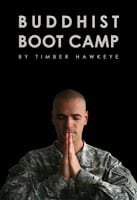
Last Thursday I went to a book-signing in town. Not so unusual, except for the way this one went. I found out about it from a friend who knows the author, Timber Hawkeye, and went in part to explore a new bookstore I had yet to go inside, and in part to support a fellow writer.
The book is called Buddhist Boot Camp and the author recently gave his first TED Talk. He has a website, a Facebook page, and a blog, none of which I had encountered. I went in knowing little of him and, in retrospect, I’m glad I didn’t spend an hour or two boning up on who he was before I went.
Upon entering the room, I saw a short (6-inch) plywood-wrapped-in-carpet stage at the far North end with rows of chairs facing it. Typical book signing/reading, right? Until the author stepped down from the stage and began rearranging the chairs into a circle. As people filed in, around 40 or so, we all chose chairs and waited. Timber spoke, “I haven’t ever done one of these before, so I don’t really know how it goes, but I do know that I want to hear from you all tonight. I don’t want to be on a stage – this is not about the messenger, it’s about the message.”
For the next hour and a half, we proceeded to share stories of meditation practices, our individual journeys to Buddhism, and ask rather frank questions of Timber (such as, “Who named you ‘Timber Hawkeye?’ – the story is an entertaining one that I won’t ruin for you in case you ever see him speak; ask him yourself).
The message in this case is pure, unadulterated, unencumbered by ritual or dogma, Buddhist principles. The book itself is short and the chapters are each only one page long. Whether you are Buddhist, Muslim, Jewish, Christian, some or all or none of the above, the topics explored in “Buddhist Boot Camp” are simple, basic, and resonate deeply. I came home wishing I had bought several copies to give as gifts (I still may) and determined to spend a little time each day exploring one of the ideas in the book. By the end of the week, I had resolved to spend a little time each week discussing one idea with Eve and Lola.
I often wonder if I am doing my children a disservice by not incorporating some sort of formal spiritual practice into their lives. I know that as a child I was thrilled with the mystique and drama of Catholic rituals, but couldn’t really reconcile them with the patriarchical dogma that was delivered in a vengeful, punitive way. Ultimately, when my parents divorced, it was a relief to leave the church. I have, from time to time, talked to the girls about Buddhism, but Timber’s book may be just the ticket to helping my girls more fully understand why I am drawn to these teachings as a way of life.


